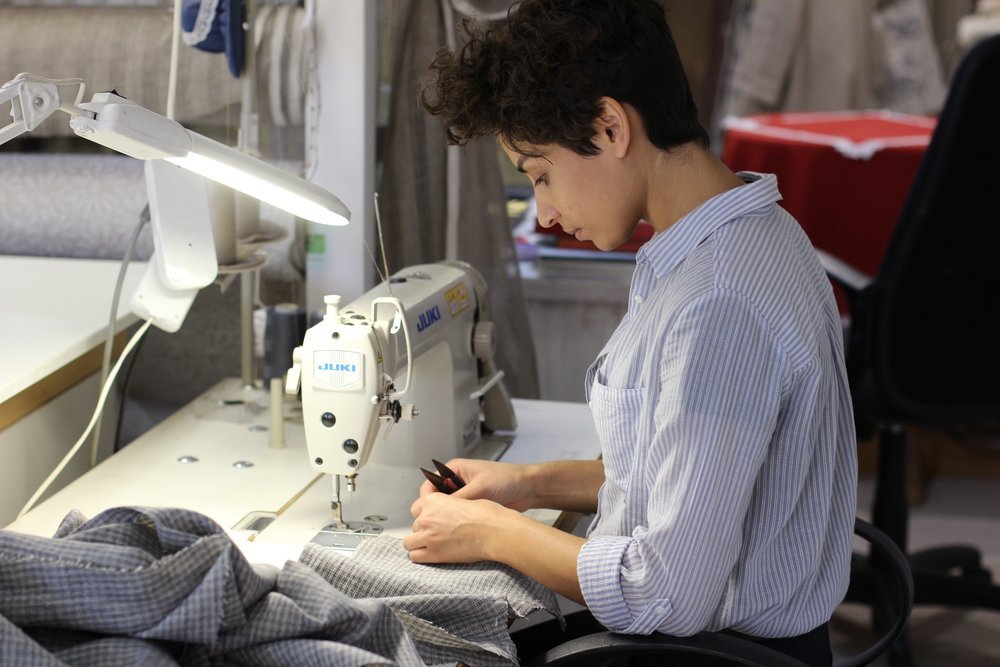Fashion Industry Terms for Manufacturing
When launching and growing a fashion brand, you will be constantly communicating with designers, product developers, suppliers and manufacturers. Understanding fashion terms and concepts is a great way for you to feel confident in these interactions from the start.
You may know some of these terms, but in the context of the fashion industry they could mean something very different. Below is an A-Z list of the most common words related to the fashion industry and apparel manufacturing.
Common Fashion Production Terms
Assortment: A collection of different types of products offered by a brand or retailer.
BOM: Stands for Bill of Materials which is a listing of all materials needed to make a certain product. Factories use these as a reference through production.
Colorway: This is an industry term for one color of a style.
COO: Stands for Country of Origin.
Cut and Sew: A term used for the process of cutting the fabric and sewing it together to make a product. It is used in pricing conversations to define the production assembly cost.
Cuttable Width: This is a term that defines the width of the fabric that can be cut and used for production.
Direct to Consumer or Direct : Selling to the consumer directly without using a wholesale or third party channel.
Duty: This is a tax you pay to import goods into the country. It is a percentage of the total value of the shipment determined by the type of product, material content and country of origin.
Fit Sample: This is a sample made by the factory for you to review and make modifications to measurements, construction and the design of your products.
FOB: This stands for Free on Board or Freight on Board. This is a international shipping term with defines who is responsible for the shipping cost. It is the location where the ownership of the product changes hands from the seller to the buyer.
Grading: The process of taking an approved pattern size and creating your full range of sizes based on the measurements.
Greige: Refers to unfinished and un-dyed fabric from a loom or knitting machine.
Gross Margin: This is your net sales revenue minus your cost of goods sold.
IMU: Stands for Initial Markup which is the amount of margin you are expected to make by selling at regular price.
Keystone: A wholesale selling strategy where the wholesale cost is exactly half of the retail price. This allows your wholesale partner to make 50% margin on the sale of your goods.
Lab Dip: This is a swatch of fabric that has been dyed to match color standards. They are sent to you for approval before the production fabric is dyed.
LDP: Stands for Landed Duty Paid. This is a method of purchasing goods overseas where the costs of the goods includes shipping, delivery, customs, duty and insurance. Logistically this is the easiest way to produce or source overseas since the goods are delivered directly to you.
Ligne: The industry unit of measurement for buttons.
Omni-Channel: Integrates all sales channels to sell to the consumer.
MAP Pricing: This stands for Minimum Advertised Price. This is a pricing strategy you can use with wholesale accounts to regulate how they price your products.
Markup: The amount added to the cost of a product to cover overhead and profit.
MOQ: Stands for Minimum Order Quantity and is used by factories and suppliers throughout the industry as a limit for how small a production order can be.
Pre-Production Sample or PP Sample: The sample created by the factory for final approval before production begins.
Prepared For Dye (PFD): This is a fabric finishing process. You would purchase PFD fabric if you planned to print or dye it yourself for production.
Retail: An industry term for the price the customer will pay for the product.
Sell-Through: The ratio of the amount of goods sold vs the amount of goods available to sell.
SKU: Stands for Stock Keeping Unit and is a specific number which is given to each variant of the products. This is an imperative unit of measure which enables you to track detailed sales information.
Specs: Also known as Specifications are details and measurements that the factory follows to ensure the correct execution of your designs. They are usually compiled into Spec Sheets.
Strike Off: This is a swatch of fabric that is printed as a test for your approval. Once approved, all fabric would be printed for production.
Sublimation: A method of fabric printing that involves a digital printer that prints designs onto heat transfer paper that can then be applied to garments or fabric.
Tech Pack: Is a complete compilation of components and construction guidance created by a technical designer for the factory to follow for production.
Tolerance: An allowable variance from the approved final spec measurements.
TOP Sample: Stands for Top of Production Sample which is a reference of how the production is being created. No modifications can be made to this style, it is purely for reference.
VAT: This is Value Added Tax which is a fee that is incurred by some countries for you to sell and ship goods internationally. Either you or the customer will be responsible for paying these fees.
Wholesale: A method of selling your product to a retailer who will then sell your product to the customer.




